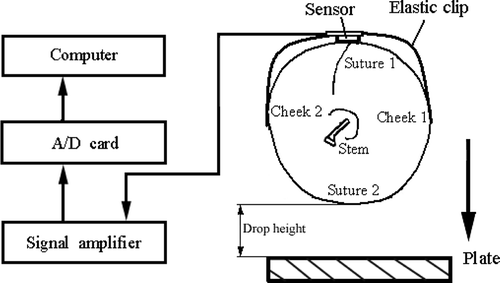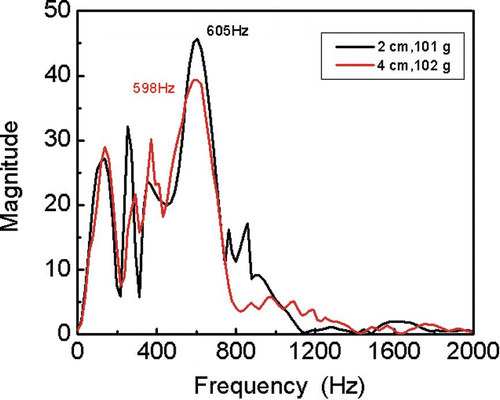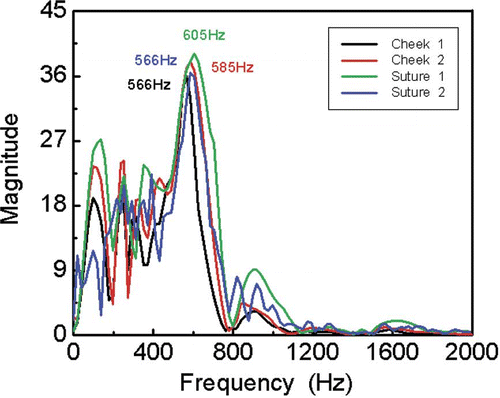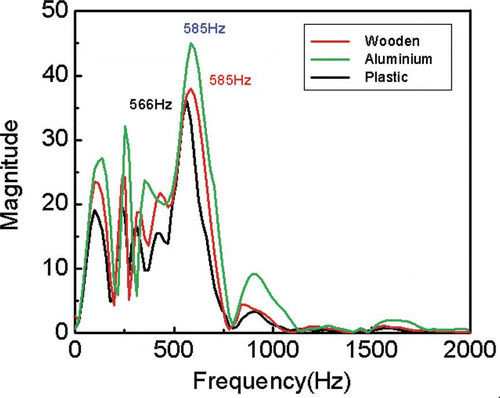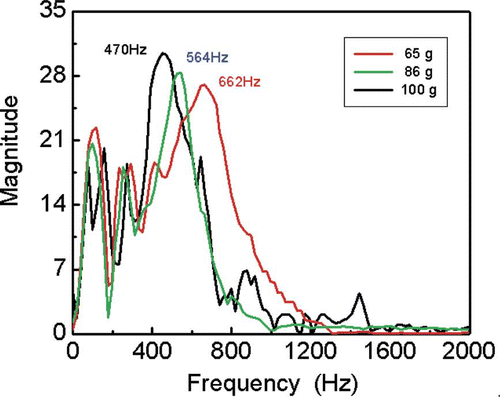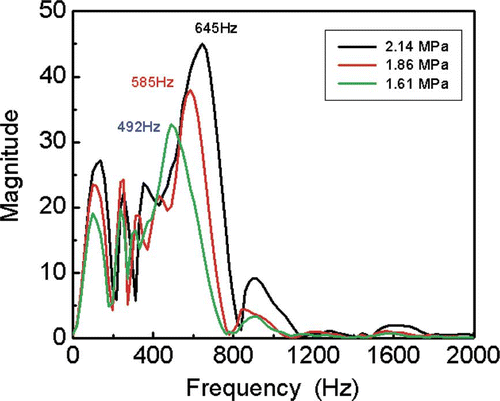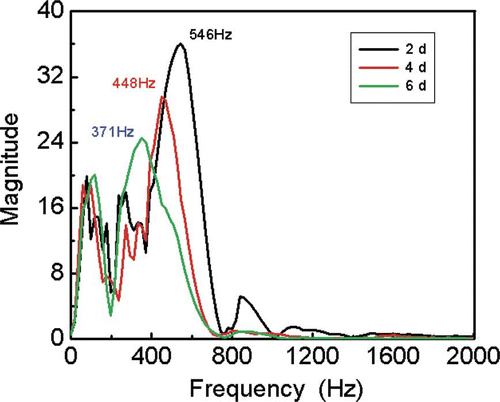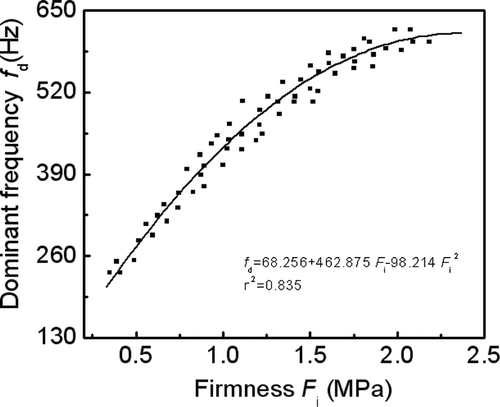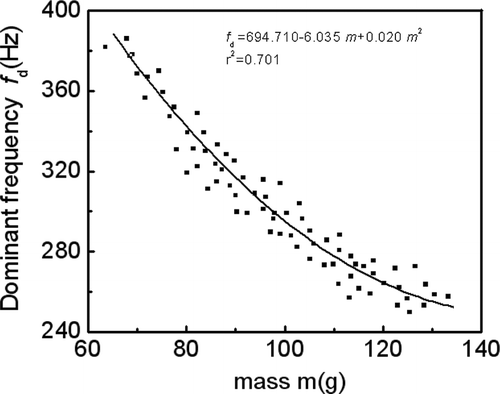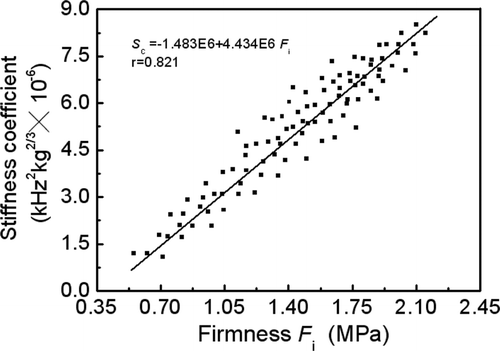Abstract
The peach dynamic resonance frequencies were obtained based on the analysis of dynamically measured response signal of an drop-excited peach with change in impacted orientation, drop height, material of impact surface, peach firmness, peach mass, and storage time of peach. After peach was impacted, response signals in time domain were detected, and transformed into frequency domain (by means of FFT). The dominant frequency (the response magnitude were the greatest) was obtained and significantly affected by peach firmness, mass, and storage time. The impacted orientation, drop height, and material of impact surface did not significantly affect the dominant frequency. The dominant frequency increased with increasing of peach firmness and decreased with increasing of peach mass. The relationships were obtained between dominant frequency and peach firmness or peach mass, and the stiffness coefficient (Sc = f2m2/3 ) regressed on Magness-Taylor firmness had a better relationship. The peach firmness could be predicted by drop impacting method.
Keywords:
INTRODUCTION
Firmness has been used as a criterion for sorting fresh fruit and vegetables for many years. The methods used include squeezing between finger (or hand), pushing a thumb into flesh, biting and chewing, and the penetrometer (generally referred to as Magness-Taylor (M-T) or Effe-gi test). Because of the destructive nature of these tests and an increasing emphasis on quality, a non-destructive method has been sought to quickly measure individual fruit for sorting. The ability to sort by firmness would help to obtain a more uniform pack of consistent high quality fruit and facilitate more timely marketing.[Citation1–5]
Non-destructive techniques for measuring firmness have been extensively investigated. Some promising dynamic methods for fruit quality evaluation were based on measurement of fruit response to force vibration and acoustic response. Good correlation was found between some resonant frequencies derived from vibration tests and mechanical properties of fruit[Citation6,Citation7], and Young's modulus, which was calculated from the acoustic response caused mechanical impulse by striking an apple with a ball of wax, had good correlation with measurement in compression tests of specimens taken from the same fruit, but poor correlation was found with the results of a standard M-T test.[Citation8] In some experiments, several apple varieties were struck mechanically, the response signal was detected by a microphone, and it was concluded that the acoustic impulse response method appeared to be more efficient and accurate than random vibration methods.[Citation9,Citation10]
To indicate firmness for approximate spherical fruit, a stiffness coefficient (S) (first introduced by Abbott et al., modified by Cooke and Rand) can be calculated as:[Citation11,Citation12]
Stiffness coefficient was significantly correlated with fruit firmness and sensory measurement.[Citation13] According to Chen and De Baerdemaeker,[Citation10] it is advisable to take the average of three measurements equally spaced on the fruit equator to reduce errors caused by variance in shape, a phenomenon inherent in horticultural products. Modal analysis on spherical product (apple) showed that the best signal was produced when the response was recorded at 0 or 180° from the place of impact.[Citation14]
Much information is available on the dynamic method of fruit. In the information, it was reported that researchers applied a frequency analysis technique to sound signals by means of a microphone. Fruit was impacted by excitation ball, and the response signals were picked up by a microphone, which was installed on the opposite side. It was observed that resonant dominant frequency decreased with maturity. Nevertheless, to our knowledge, dynamic excitation method by a microphone has not yet been successfully adapted to detection and sorting. The microphone signals were subjected to surrounding noise, including the other signal of excitation process and grading situation. One reason may be that the microphone did not cling or adhere to the fruit. It was reported that although the non-destructive method (by means of impact hammer and microphone obtained response signal) was correlated with M-T penetrometer, it was not acceptable to the fruit industries for commercialization.[Citation15]
There have been some studies on fruit firmness measurement by drop impact where the impact forces were measured (by force sensors) and analyzed, rather than the vibration (by acceleration sensor), but the methods have not been successfully developed for grading.[Citation16] The development of low-cost, lightweight, and piezoelectric film acceleration sensors has opened new possibilities for dynamic testing of agricultural products in the packing house. It becomes feasible to study dynamic characteristics and evaluate firmness of fresh agricultural products because the sensors cling to fruit surfaces, which can detect the signal immediately from the excitation of fruit and the sensors are rarely affected by surrounding noise.
In this research, peach was impacted by free drop; the response signal was detected by a piezoelectric sensor, and the dynamic response characteristic was analyzed. The specific objectives of the research by basic on piezoelectric film sensor were to: (1) analyze the response time signals and frequency signals of peaches; (2) find effect factors on dynamic resonance frequency; and (3), establish a relationship between the dominant frequency, firmness, and mass of samples.
MATERIALS AND METHODS
Peach Samples
The test samples “Pointred peaches” were hand harvested in 2002 from the experimental orchard in the Department of Horticulture, Zhejiang University; extremely large and small peaches were rejected. Upon arrival at the laboratory, peaches were again inspected to ensure that they were uniform, undamaged, and worm free. After inspection, the peaches were held at room temperature (about 18–22°C) for 10 hours before testing, except for storage experiments.
Experimental System
An experimental setup was developed using a piezoelectric acceleration film transducer to detect resonance signal of peach. The experimental setup consisted of a piezoelectric sensor, the impact wooden (or aluminium alloy or plastic) plate, signal amplifier, a personal computer and software to control the experimental setup and to analyze its results. A schematic diagram of the system is presented in .
The sensor was a relatively new piezoelectric transducer based on a polyvinylidene fluoride (PVDF) film, coated with two thin layers of conductors (Model CA-108, China-YEC Inc., Yongzhou). Sensor dimension was 35 × 12 mm × 30 μm and a flexible, lightweight sensor, which can be fastened to a vibrating body with substantially altering its motion. The sensor clings to the cheek (or suture) of peach by means of an elastic clip, and the opposite cheek (or suture) would be impacted when peach dropped. The peach tested was freely dropped, one cheek or suture of peach impacted. The peach response signal was picked up by the piezoelectric sensor that was coupled through an amplifier and a commercial A/D PC board to the PC, which simultaneously served as the data acquisition system. The optical sensor was used to trigger the acquisition. The signal was sampled at a rate of 100,000 samples/s for a period of 20 minutes. The MATLAB 5.3 computer program transformed the response from time to frequency domain by means of Fast Fourier Transform (FFT), as demonstrated in . A search algorithm was used to identify the first resonance frequency of the peach. Preliminary tests were performed in order to identify a proper drop height, which did not cause any damage to peach tissue. As a result of preliminary tests, a drop height of < 5 cm was selected for all further tests.
Figure 2 Typical time domain and frequency domain characteristic for drop height. (Firmness 0.98–1.01MPa)
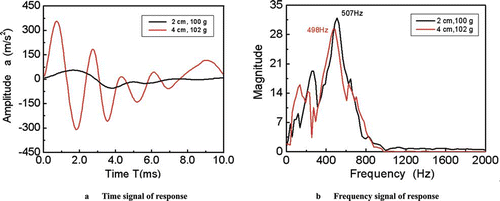
Drop impacts were made at four locations (orientation: cheek 1, cheek 2, suture 1, and suture 2) along the largest circumference of the fruit using three materials of impact surface of wooden, aluminum alloy, and plastic, respectively, and two-drop height of 2 cm and 4 cm. Except for notice, peaches dropped onto aluminum plate for orientation cheek 1 and the response signal was detected on orientation cheek 2 of the equator.
Experimental Procedure
Before the excitation experiments, the masses of the peaches were measured. When peach dropped, the response acceleration signals were detected, and the MATLAB computer program was used to transform the response signal from the time domain to the frequency domain by means of FFT. The dynamic response curves in the time and the frequency domain were analysed, statistically. The experiments were complete for five replicates. After the excitation experiments, the Magness-Taylor firmness of peach (firmness of destructive penetration) was measured at two orientation-points (cheek 1 and cheek 2) in peach equator by using an Instron 5543 Universal Testing Machine. Penetration tests were conducted with the diameter 5 mm die by penetrating into 10 mm, the loading rate of the crosshead was 25 mm/min. The M-T firmness was the mean of “the maximum force/penetration area” for two-orientation points.
RESULTS AND DISCUSSION
Effect of Drop Height
The peach dropped onto aluminium plate from two-drop heights, the response signals were detected orientation cheek 2 of the equator, and the typical acquisition signals in the time domain and their FFT to the frequency domain were shown in and . The higher the sample dropped, the higher the peak acceleration signal was detected for ripe peach (). The dominant resonance frequency (or peak frequency, the response magnitude is the greatest) could be obtained in frequency spectrum (, ). The dominant frequencies were small difference between from 2 cm and 4 cm drop heights. The dominant frequency was slightly lower and the magnitude of dominant frequency was slightly smaller from 4 cm drop height.
Effect of Dropping Orientations
The peaches were dropped from 2 cm height at orientation cheek 1, cheek 2, suture 1, and suture 2 of the equator, respectively, and the response signals were obtained on each opposite equator orientation, the typical frequency domains were shown in . No significant difference was found in the dominant frequency for four impact-orientations when other physical properties of peaches were identical. This agreed with Wang who found that the mechanical properties of pears were not affected by the fruit's orientation.[Citation3]
Effect of Impact Surface Material
The peaches were dropped and impacted on the orientation cheek 1 of the equator from 2 cm height and the response signals were detected on orientation cheek 2 of the equator. The materials of impact surface were wooden, aluminium alloy, and plastic respectively, the frequency domains were shown in . The impact materials did not appear to affect the dominant frequency, but it did affect the magnitude of dominant frequencies. The magnitude of dominant frequency obtained when peach impacted on aluminium alloy surface was higher than those obtained on the other two surfaces. There may be a correlation with impacting material stiffness and impacting contact time. This is consistent with the findings of the higher magnitude from Galili et al. for avocado samples by an aluminum ball impact and the response signals were picked up by a microphone.[Citation17]
Effect of Fruit Mass
The typical frequency response curves of dropped impact for different peach mass under the same M-T firmness were shown in . The fruit mass had an effect on the dominant resonance frequency. The greater the fruit mass, the lower the dominant frequency, but the greater the magnitude. As the density of samples picked in the same period are approximate, the smaller mass must gave a smaller volume, and the signal transmitted fast, high frequency signal may be little absorbed by small fruit. This agreed with the findings of Galili et al. and Gomez et al.[Citation17,Citation18].
Effect of Fruit Firmness
showed the typical frequency response curves of fruit with different firmness. The dominant resonance frequency and its magnitude were higher with increase of firmness or in firmer fruit when other physical properties were identical. i.e. the greater the M-T firmness, the higher the dominant frequency. This was consistent with the findings of the other researchers for the fruit impact response by means of a microphone.[Citation8,Citation9] It may be implied that the peach firmness was detected by using the resonance frequency of film sensor.
Dynamic Response with Storage Day
The typical frequency response curves of dropped impact with storage day (18–21°C) for ripened peach were shown in . The value of dominant frequency and the magnitude of dominant frequency decreased with increase of storage day. This may be reason that peach tissue become flab and firmness decrease during storage process, which result in the dominant frequency decrease. This was consistent with that the greater firmness, the higher the dominant frequency because fruit firmness decrease with increase of storage day.[Citation18]
DIFFERENCE LEVEL AND RELATIONSHIPS
Level of Difference
To evaluate the effect level of peach mass (65, 85, 100, ± 4 g), peach firmness (1.60, 1.85, 2.15, ± 0.06 MPa), drop height (2, 4 cm), materials of impact surface (wooden, aluminium alloy, plastic), impact orientation (cheek 1, cheek 2, suture 1, suture 2), and storage day (0, 2, 4, 6 d) on the dominant frequency, statistical analyses of the experimental results were performed using the SAS/STAT procedure[Citation19], and are summarized in . The magnitudes of the F-values indicate the relative importance of effects. The dominant frequency was significantly affected by peach firmness, mass and storage day. Based on the magnitudes of the F-value, it appears that M-T firmness affected the dominant frequency most significantly. So peach firmness may be detected by using dynamic resonance frequency analysis when peach mass was considered. The peach orientation, materials of impact surface and drop height did not significantly affect the dominant frequency. and suggested that consistent readings could be achieved without a limited range of fruit position in peach equator, and the orientation cheek 1 or 2 be impacted considering the sensor is convenient adhered and experiments were expediently operated. Selection of the aluminium alloy, which the magnitude of dominant frequency will be the greater, was suggested to the material of impact surface from and Table . The drop height should not cause any damage to peach tissue.
Table 1 F-values from STAT/ANOVA on the effects
Relationship Between Dominant Resonance Frequency and Destructive Firmness
The relationship between dominant frequency and M-T firmness with similar peach mass readings (102–105 g) was shown in . The correlation coefficient was r2 = 0.835, a good quadratic correlation occurred between M-T firmness and dominant resonance frequency. The dominant resonance frequency, obtained by this non-destructive method, could be used for evaluation of peach firmness.
Relationship Between Dominant Resonance Frequency and Mass
The relationship between dominant resonance frequency and peach mass for samples with similar firmness (0.76 MPa–0.80 MPa) was shown in . In general, for the peaches picked in the same period, the dominant resonance frequency decreased when mass increased. Regression analysis showed there was a quadratic correlation between both parameters and the coefficient of correlation was r2 = 0.701. This is consistent with the finding of Duprat et al. for samples of apple.[Citation20] So, peach mass should not be ignored when firmness was evaluated by dynamic resonance method.
Relationship Between Stiffness Coefficient and Destructive Firmness
The stiffness coefficient (Sc) of fruit (ripeness firmness index) may be calculated as: Sc = f 2 m 2/3 which was applied to evaluate fruit texture in several works. The Magness-Taylor firmness was used in fruit because of the acceptance of this measurement in the handling, processing and storage operations. The relationship between the stiffness coefficient and the value of M-T penetration firmness was shown in . The stiffness coefficient regressed on the Magness-Taylor firmness had a good linear relationship, with coefficient of correlation of r = 0.821. This may be implied that peach firmness could be considered to detect by using the dynamic resonance frequency analysis of drop impact. But the r = 0.821 implied coefficient not a strong relationship, also. The Magness-Taylor firmness is a measurement of the crushing and shearing strength of the tissue and not of its elastic properties, while the stiffness coefficient is thought of as an elastic property index.[Citation8,Citation20] Similar results were obtained for “Law Rome apple,” “Golden Delicious apple” and “Avocado”.[Citation8,Citation10,Citation20]
CONCLUSIONS
The peach dynamic resonance frequencies were obtained based on analysis of the dynamically measured frequency response of peach dropped onto a plate, and the effect of impact orientation, drop height, material of impact surface, peach firmness, peach mass, and storage day were analyzed. The findings are summarized below:
-
The dominant frequency was significantly affected by peach firmness, mass, and storage day.
-
Drop height, peach orientation, and material of impact surface did not significantly affect the dominant frequency.
-
Dominant frequency increased with increase of peach firmness, and dominant frequency decreased with increase of peach mass. A better relationship was obtained between dominant frequency and peach firmness or mass, and the stiffness regressed on Magness-Taylor firmness showed a good correlation. The peach firmness could be considered to detect by using the dynamic resonance frequency analysis of drop impact.
ACKNOWLEDGEMENTS
The authors acknowledge the financial support of the Chinese National Foundation of Nature and Science through project 30170533 and 30570449 and the financial support of Program for New Century Excellent Talents in Chinese University through project NCET-04–0544.
REFERENCES
- Blahovec , J. 2002 . Mechanics of poppy seeds . International Journal of Food Properties , 5 ( 2 ) : 277 – 278 .
- Shigehiko , O. , Tomoyuki , F. and Osato , M. 2002 . Electrical and rheological analysis of freezing injury of agricultural products . International Journal of Food Properties , 5 ( 2 ) : 317 – 322 . [CROSSREF]
- Wang , J. 2004 . Mechanical properties of pear as a function of location and orientation . International Journal of Food Properties , 6 : 155 – 164 . [CROSSREF]
- Akanbi , C.T. and Oludemi , F.O. 2004 . Effect of Processing and Packaging on the Lycopene Content of Tomato Products . International Journal of Food Properties , 7 ( 1 ) : 139 – 152 . [CROSSREF]
- Chauhan , O.P. , Chauhan , G.S. , Sharma , P. , Bajpai , A. and Yadav , D.N. 2003 . Effect of Varieties on the Quality Characteristics of Roasted Soybean . International Journal of Food Properties , 7 ( 1 ) : 281 – 289 . [CROSSREF]
- Affeldt , H.A Jr. and Abbott , J.A. 1989 . Apple Firmness and Sensory Quality Using Contact Acoustic Transmission . In Proc. of the Eleventh Int. Congress on Agricultural Engineering . Mar. 13–15 1989 , Davis, California.
- Van Woensel , G. , Verdonck , E. and De Baerdermaeker , J.D. 1988 . Measurering the mechanical properties of apple tissue using modal analysis . Journal of Food Process Engineering , 10 : 151 – 163 .
- Armstrong , P.R. , Zapp , H.R. and Brown , G.K. 1990 . Impulse excitation of acoustic vibrations in apples for firmness determination . Transactions of the ASAE , 33 ( 4 ) : 1353 – 1359 .
- Chen , P. and Sun , Z. 1991 . A review of non-destructive methods for quality evaluation and sorting of agricultural products . Journal of Agricultural Engineering Research , 49 : 85 – 98 . [CROSSREF]
- Chen , H. and De Baerdemacker , J.D. 1993 . Model analysis of the dynamic behavior of pineapples and its relation to fruit firmness . Transactions of the ASAE , 36 ( 5 ) : 1439 – 1444 .
- Abbott , J.A. , Bachman , G.S. , Childers , N.F. , Fiztgerald , J.V. and Matusik , F.J. 1968 . Sonic techniques for measuring texture of fruit and vegetables . Food Technology , 22 : 635 – 645 .
- Cooke , J.R. and Rand , R.H. 1973 . A mathematical study of resonance in intact fruit and vegetables using a three media elastic sphere model . Journal of Agricultural Engineering Research , 18 : 141 – 157 . [CROSSREF]
- Galili , N. and De Baerdemaeker , J.D. 1996 . Performance of Acoustic Test Methods for Quality Evaluation of Agricultural Products . ISMA Conference . September 1996 , Leuven, Belgium.
- Huarng , L. , Chen , P. and Upadhyaya , S. 1993 . Determination of acoustic vibration modes in apples . Transactions of the ASAE , 36 : 1423 – 1429 .
- Abbott , J. 2002 . Technologies for nondestructive quality evaluation of fruit and vegetables . Horticultural Review , 20 : 1 – 120 .
- Delwiche , M. 1989 . An impact force response fruit firmness sorter . Transactions of the ASAE , 32 : 321 – 326 .
- Galili , N. , Shmulevich , I. and Benichou , N. 1998 . Acoustic test of avocado for fruit ripeness evaluation . Transactions of the ASAE , 41 ( 2 ) : 399 – 407 .
- Gomez , A.H. , Wang , J. and Pereira , A.G. 2005 . Acoustic impulse response of pear and its relation to Magness-Taylor firmness during storage . Postharvest Biology and Technology , 35 : 209 – 215 . [CROSSREF]
- SAS . 1999 . Sas system release 6.12 , Cary C27513, USA : SAS Institute Inc .
- Duprat , F. , Grotte , E. , Pietri , E. and Loonis , D. 1997 . The acoustic impulse response method for measuring the overall firmness of fruit . Journal of Agricultural Engineering Research , 66 ( 1 ) : 251 – 259 . [CROSSREF]
